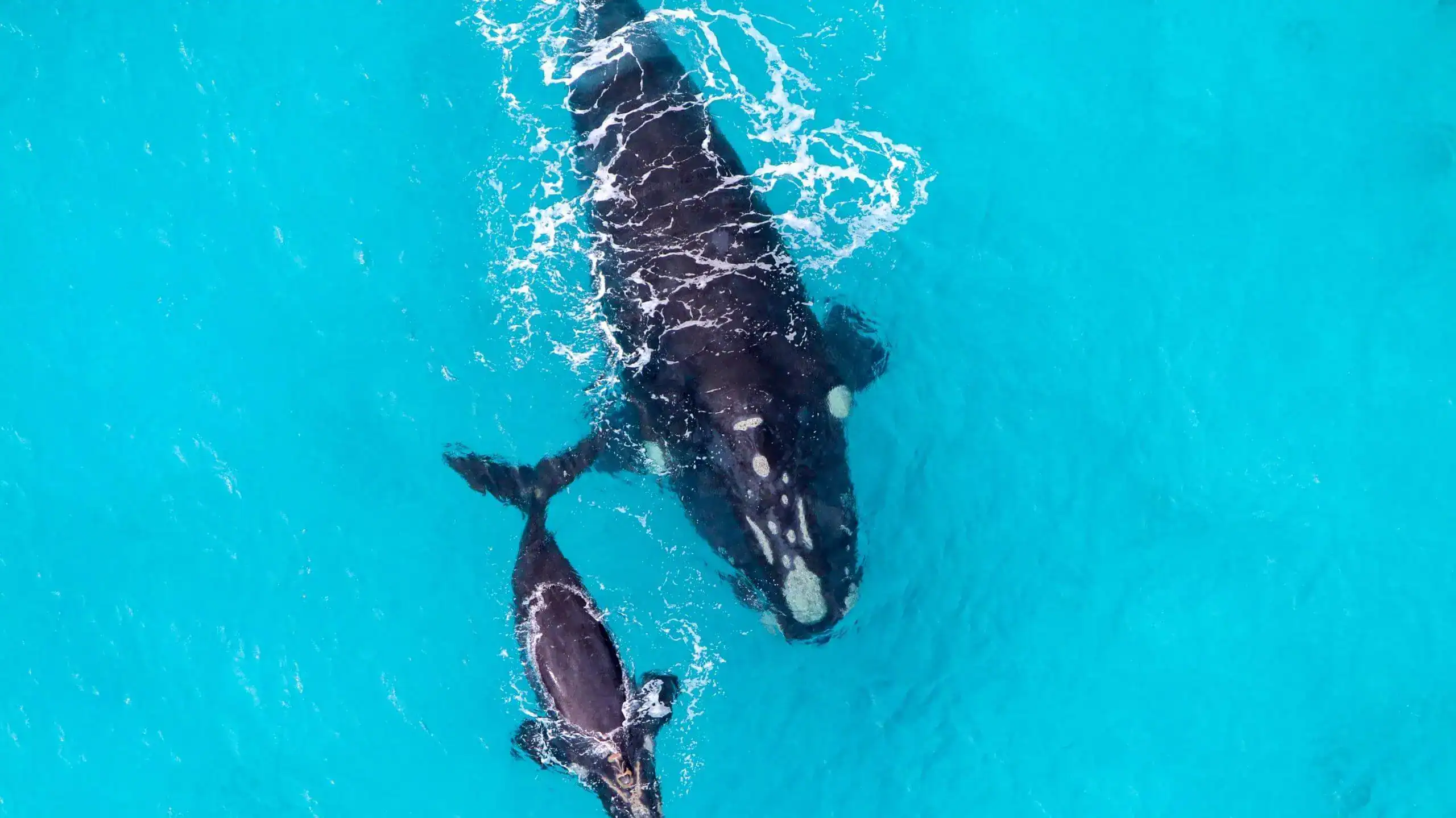Projects
Right Whale Tracker Project
The Right Whale Tracker – Improving capability of communities to measure and monitor population demographics of southern right whales along the south coast between Albany and Hopetoun following all whale watching regulations.
Want to get involved? REGISTER HERE
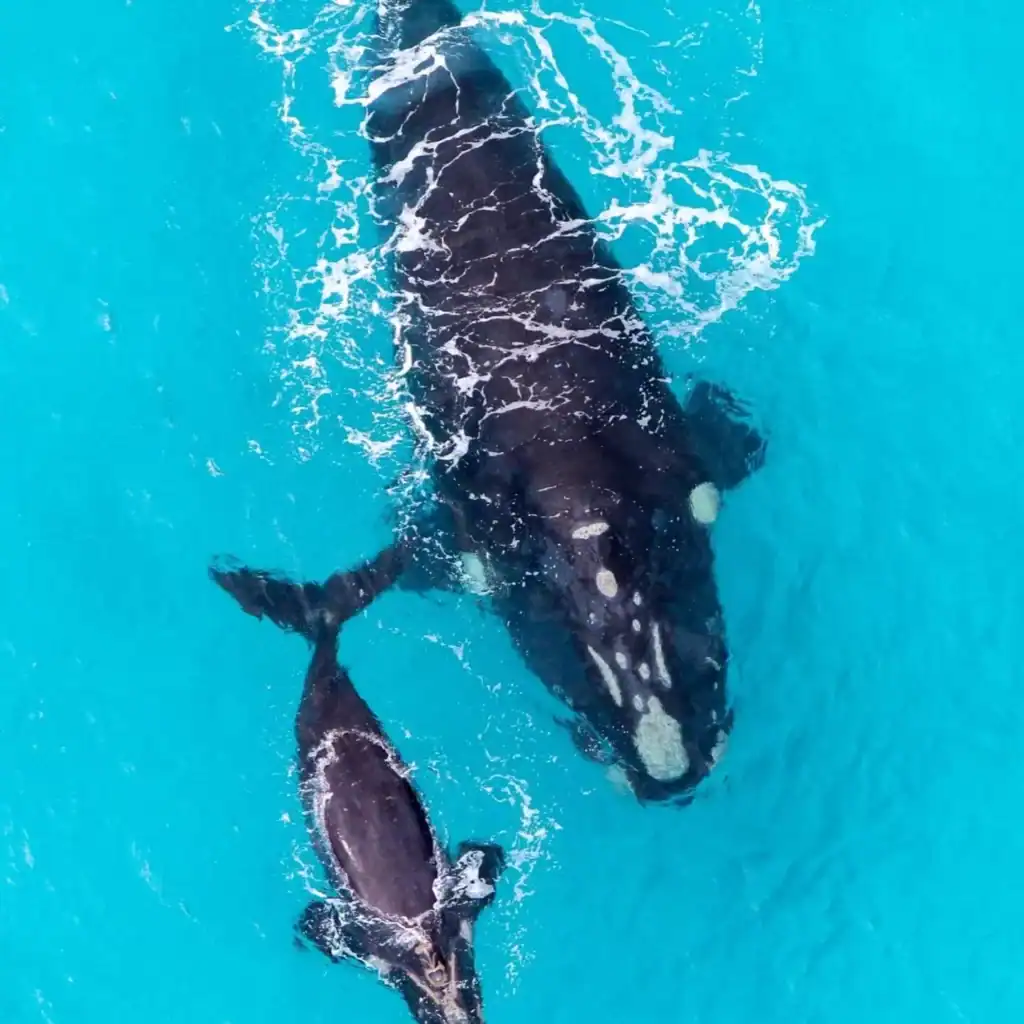
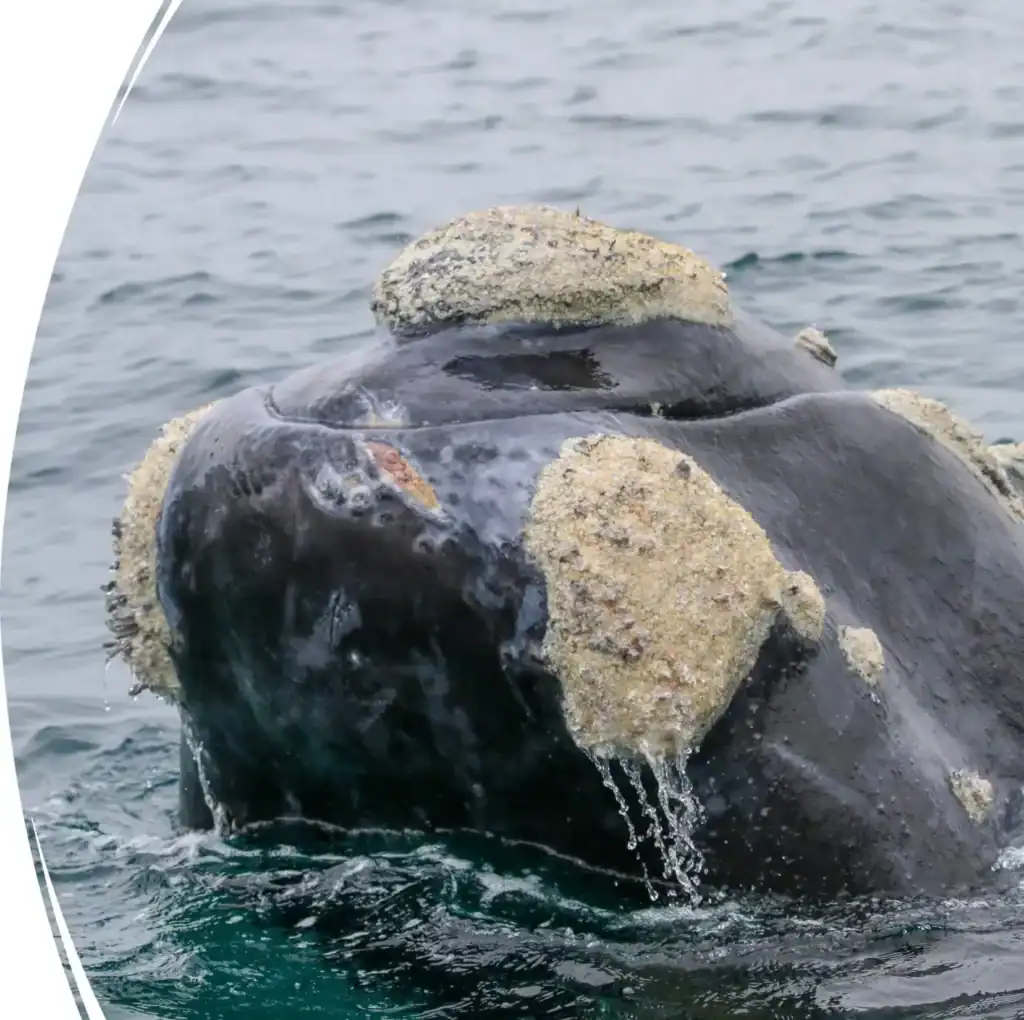
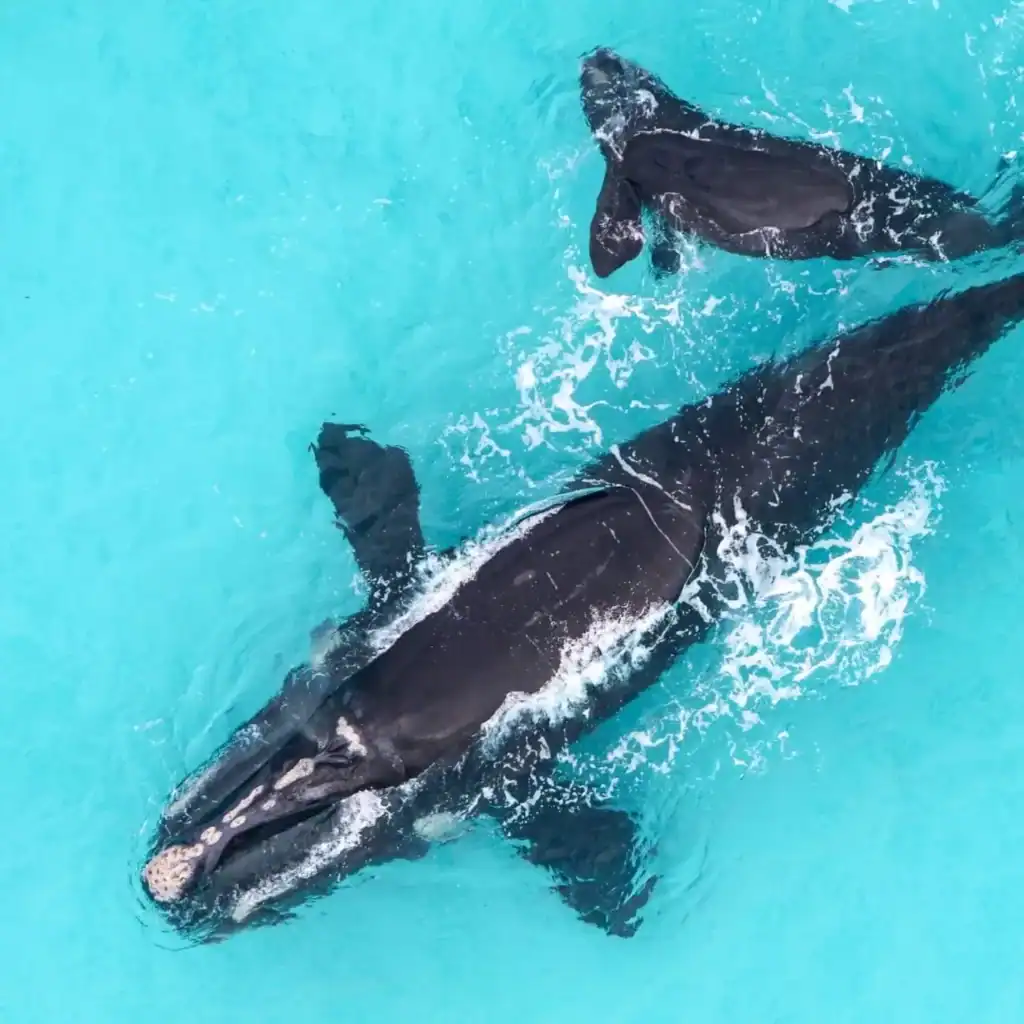
About the Project
About Southern Right Whales
The Southern Right Whale (Eubalaena australis) is an endangered species, also called mamang in the Noongar language, a language spoken by Aboriginal peoples in the south-western region of Western Australia.
Appearance
Southern right whales can grow up to 18 metres long and weigh up to 100 tonnes. Their skin is usually black, but they can also be grey, often with white belly and chin patches and a large head covered in callosities. The head can be up to one-third of their body length, with a strongly arched mouth.
How do I identify a southern right whale?
- Callosities – they have roughened patches of skin on their heads, chins, and lower jaws that are unique to each whale. These patches are calloused areas colonized by tiny white crustaceans.
- Fins – they have wide, paddle-shaped pectoral fins and they lack a dorsal fin
- Tail – they have a broad tail with flukes that form a wide triangle with a notch in the middle.
- Blow holes – they have two separate blow holes that produce a V-shaped cloud of vapor when they breath.
- Speed – slow moving behaviour.
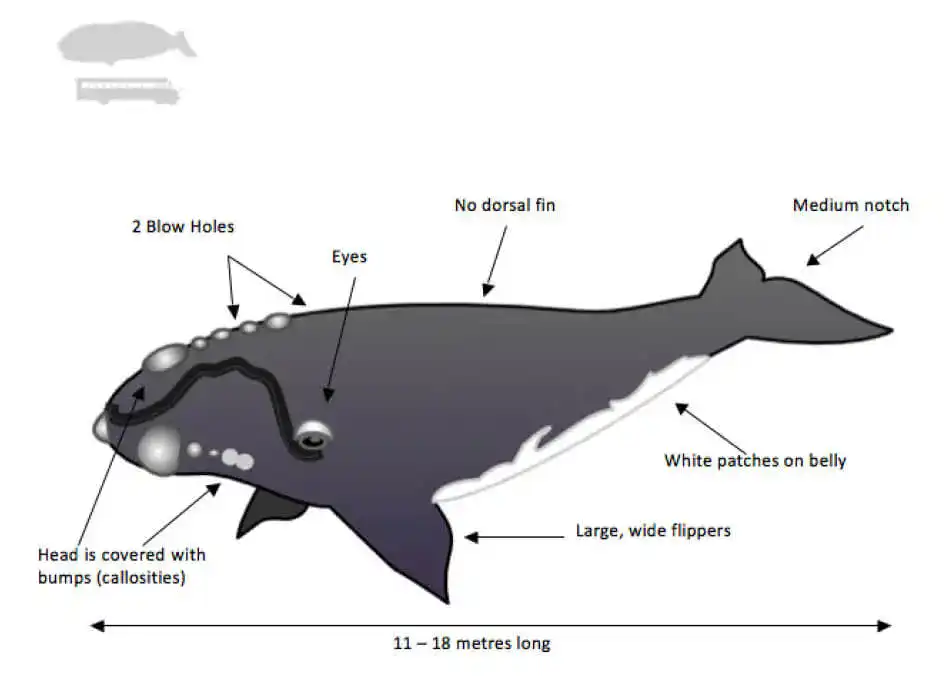
Distribution and habitat
The Southern Right Whale inhabits the southern and sub-Antarctic oceans except during the winter breeding season. During this breeding season the whales migrate to warmer temperate waters around the southern parts of the African, South American and Australian land masses.
Biologically Important Areas for Southern Right Whales
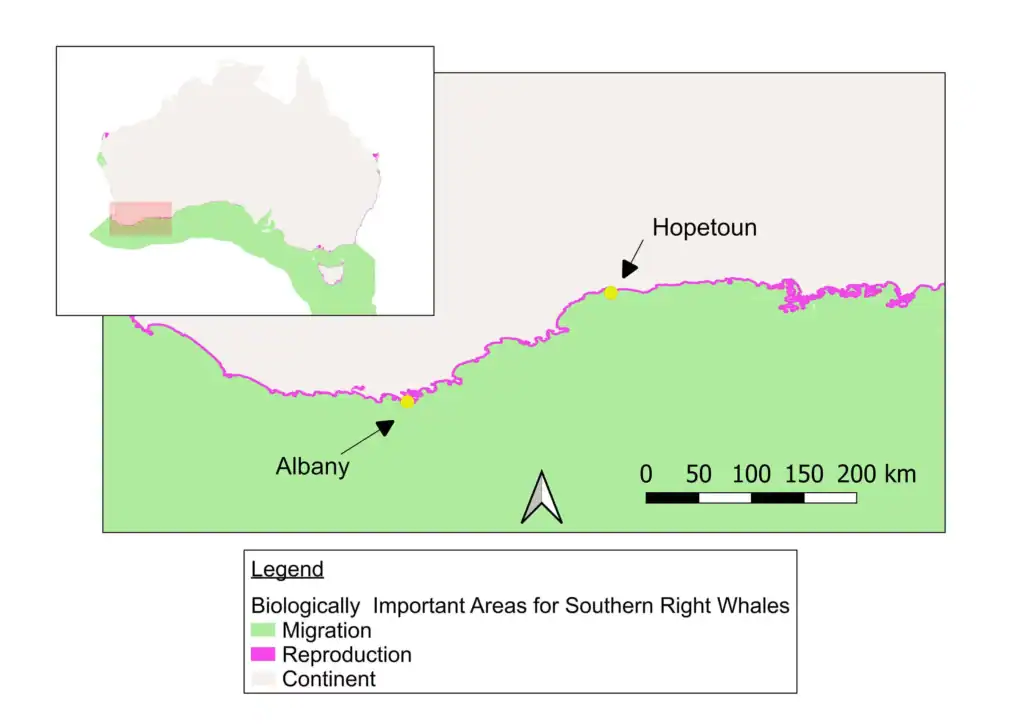
Conservation status
The Australian populations consist of two recognised sub-populations which in the 2022 annual aerial survey estimated these populations to be –
- the western sub-population 2675
- the eastern sub-population 268
Australia has a clear obligation to protect and conserve Southern Right Whales. They are listed as an endangered species through the
- EPBC Act 1999 (Commonwealth legislation)
- Western Australian Biodiversity Conservation Act 2016 (State legislation)
Key Challenges
Southern right whale traits, such as living long lives, late sexuality maturity and low reproductive output, makes them vulnerable to anthropogenic threats –
- Vessel Strikes – may cause serious injuries or death, mother and calf pairs are particularly vulnerable. Larger and faster vessels are more likely to cause death.
- Noise Pollution – such as from vessels, development or construction, and seismic activities can have the potential to cause displacement from critical habitat, disrupt behaviour temporarily or permanently, mask natural sounds, impact hearing, cause stress, physical injury and interfere with communication including potentially causing separation of mother and calf pairs.
- Marine Pollution – including marine debris, oil, sewage and other anthropogenic contaminants. Marine debris can be ingested, or cause entanglement, resulting in injury, starvation, impaired movement or drowning. Chemical pollution can cause impaired health, reproduction and immune function or death.
- Climate change – changes such as increasing temperatures impacting food sources and habitat suitability for calving.
Project Details
May 2024 saw the commencement of the Right Whale Tracker Project – a program that works with citizen scientists and community to measure and monitior Southern Right Whales along the south coast from Albany to Hopetoun. It draws from the experience and passion of community, volunteers and whale watch operators supported by funding from the Western Australian Government’s State NRM Program. This program is delivered through a collaboration between South Coast NRM, South Coast Cetaceans and Oceans Blueprint. South Coast Cetaceans, developed by Kirsty Alexander, has been engaging volunteer citizen scientists to gather data, assisting in informing management strategies for coastal development along the South Coast since 2016. The Right Whale Tracker project will continue collecting this baseline data for the next 2 years with the support of ECU’s National Environmental Science Program (NESP) Project 3.15 for reporting.
Monitoring a highly mobile marine species across the south coast over long periods (decades) requires a network of trained observers to collect key biological information during, each three to four-month reproductive season. This prolonged broad-scale effort tends to be prohibitively costly and logistically difficult to do through traditional scientific research activities and resources.
This project is designed to coordinate a training and management program that delivers engagement and outreach that inspires a strong sense of value in community members dedicated to the Right Whale Tracker project.
Specifically, the project focusses on improving the capability of citizen scientists and community to measure and monitor southern right whales along the south coast from Albany to Hopetoun. The purpose is to continue and build on the work of Kirsty Alexander’s South Coast Cetaceans, to continue on-going long term citizen science Southern Right Whale monitoring to collect, store and make publicly available data on Southern Right Whale populations that will contribute to the conservation of Southern Right Whales.
Monitoring southern right whale populations provides a unique experience for the community to engage with their local environment on an ongoing, long-term basis, enhancing community cohesion, raising greater awareness of marine environments, encouraging marine stewardship and creating positive behavioural change towards greater personal and community conservation practices.
Online Training Module
Summary
Right Whale Tracker is a collaboration between South Coast Cetaceans, South Coast Natural Resource Management, Oceans Blueprint and Edith Cowan University supported by funding from the Western Australian Government’s State NRM Program and the Australian Government under the National Environmental Science Program.
The Citizen Science Training Toolkit aims to equip Citizen Scientists and Indigenous Rangers with the knowledge and skills necessary to effectively contribute to Right Whale Tracker project. The training toolkit has been developed for face-to-face delivery, with the possibility of a self-paced online format in the future.
The Toolkit developed by the Oceans Blueprint team – Kerstin Bilgmann and Chandra Salgado Kent includes the following resources –
- A Citizen Science Training Toolkit Summary
- Four Training Modules for delivery as Power Point presentations
- Additional reading material references
- A Volunteer Management Handbook
- A Volunteer Registration Form
- A Work Health and Safety Policy
- A Job Safety Analysis Form (for land and/or vessel surveys)
- Volunteer registration through the My Impact online platform
The content below summarises in brief the content of the four Training Modules-
Module 1 – Understanding the Project, SRW Conservation, Ecology & Biology
- History of southern right whale abundance
- Biologically important areas & critical habitat
- Recovery and legislations
- Understanding the project (purpose and goals)
- Southern right whale conservation biology and ecology
- Identification of species & individuals
- Data collection
Module 2 – Scientific Methods, Protocols, and Data Collection
- Scientific methods for data collection
- Step-by-step protocols for data collection
- How to use specific data sheets and technology for data collection
- Marine Fauna Sightings smartphone app introduction video
- Troubleshooting common issues
Module 3 – Exercises (interactive element)
- Species identification
- Behavioural categories in Marine Fauna Sightings app
- Behaviour identification
- Photo identification
- Camera settings
- Track data
Module 4 – Code of Conduct, Data Usage and Risk Assessment
- Volunteering for Right Whale Tracker
- Code of Conduct (expected ethics and conduct)
- Work Health and Safety
- Rules when watching whales
- Forms to sign
Help us identify our local Southern Right Whales
Get involved with
Citizen Science
Anyone can become a Right Whale Tracker citizen scientist. Fill out this form to register your interest in becoming a Right Whale Tracker.
If you are interested in learning about southern right whales and becoming a citizen scientist you can help fill in critical knowledge gaps to help conserve the species and empower our community to engage directly in conservation-based management actions.
An annual free face-to-face training event is run in Albany and Hopetoun, or you could try our online training.
Once you have registered our project coordinator Laura Bird will contact you with details on the training sessions or the link/s to the brand-new online training modules prepared by our Southern Right Whale scientists.
How to submit a survey report
After signing up and training to be a RWT citizen scientist there are 3 different ways you can make a survey report.
- Marine Fauna Sighting App created by DPIRD
- Right Whale Tracker Survey Data sheet online
- Right Whale Tracker Survey Data sheet paper copy
All three methods ask the same survey questions and can be used for both land based surveys and vessel based surveys.
Complete the questions using one of the three methods above and where you can take photos with a high zoon camera of the whales you have seen. When you take your photos with a high zoom camera we can use this data to identify individuals. If you use your phone camera it will only help identify the species.
Name the images using this format: yyymmdd_initials_location_image number and include this on your survey report.
Send any paper copies of the survey reports and any labelled photos to LauraB@southcoastnrm.com.au using email, or if the image is too large you can use WeTransfer and send to LauraB@southcoastnrm.com.au
If you choose to use the Marine Fauna Sighting App you need to download the Department of Primary Industries & Regional Development (DPIRD) Marine Fauna Sightings (MFS) App and create a user profile to record opportunistic sightings using your phone camera to identify the species.
Awareness raising
South Coast NRM and other Project Partners are raising awareness for the conservation of Southern Right Whales through various communications and events.
Further resources
Additional reading material and references
- Australia National Whale Watch Guidelines, Department of Climate Change, Energy, the Environment and Water (DCCEEW)
- Environmental Protection Biodiversity and Conservation Act (1999), DCCEEW
- International Convention on Biological Diversity
- Marine Fauna Sighting App Introduction Video
- National Recovery Plan for the SRW 2024
- South Coast NRM Volunteer Management Handbook: A guide for engaging volunteers at South Coast NRM
- Smith, J.N., Double, M., Evans, K. and Kelly, N. (2023) Relative abundance of the ‘western’ population of southern right whales (Eubalaena australis) from an aerial survey off southern Australia: Final Report on 2022 survey. Report to the National Environmental Science Program. Murdoch University (Lead organisation).
- WA Biodiversity Conservation Act (2016)
- WA Biodiversity Conservation Regulations (2018)
- WA DBCA Whale Watch Guidelines
Appendix to the Citizen Scientist Guide
- DOI: Jackson JA, Patenaude NJ, Carroll EL & Baker CS. (2008). How Few Whales Were There after Whaling? Inference from Contemporary Mtdna Diversity. Molecular Ecology 17, 1, 236- 251.
- Department of Climate Change, Energy, the Environment and Water. (2024). National recovery plan for the Southern Right Whale. Australian Government.
- DOI: Kenney RD. (2018). Right Whales: Eubalaena Glacialis, E. Japonica, and E. Australis, in B. Würsig, J. G. M. Thewissen and K. M. Kovacs. Encyclopedia of Marine Mammals (Third Edition). Academic Press. pp 817-822.
- DOI: Mackay AI, Bailleul F, Carroll EL, Andrews-Goff V, Baker CS, Bannister J, Boren L, Carlyon K, Donnelly DM, Double M, Goldsworthy SD, Harcourt R, Holman D, Lowther A, Parra GJ & Childerhouse SJ. (2020). Satellite Derived Offshore Migratory Movements of Southern Right Whales (Eubalaena Australis) from Australian and New Zealand Wintering Grounds. PLOS ONE 15, 5, e0231577.
- Townsend CH. (1935). The Distribution of Certain Whales as Shown by Logbook Records of American Whaleships. Zoologica 19, 1-50.
- Bannister JL, Burnell SR, Burton C & Kato H. (1997). Right Whales Off Southern Australia: Direct Evidence for a Link between Onshore Breeding Grounds and Offshore Probable Feeding Grounds. Report of the International Whaling Commission.
- DOI: Tormosov DD, Mikhaliev YA, Best PB, Zemsky VA, Sekiguchi K & Brownell RL. (1998). Soviet Catches of Southern Right Whales Eubalaena Australis, 1951-1971. Biological Data and National Recovery Plan for the Southern Right Whale (Eubalaena australis) 94 Conservation Implications. Biological Conservation 86, 2, 185-197.
- DOI: Burnell SR & Bryden MM. (1997). Coastal Residence Periods and Reproductive Timing in Southern Right Whales, Eubalaena Australis. Journal of Zoology 241, 4, 613-621.
- DOI: IWC. (2010). Report of the Workshop on Welfare Issues Associated with the Entanglement of Large Whales. . IWC Document 9. IWC/62/15. Peel D, Smith JN & Childerhouse S. (2018). Vessel Strike of Whales in Australia: The Challenges of Analysis of Historical Incident Data. Frontiers in Marine Science 5, 69, 69.
- DOI: Tulloch VJD, Plagányi ÉE, Brown C, Richardson AJ & Matear R. (2019). Future Recovery of Baleen Whales Is Imperiled by Climate Change. Global Change Biology 25, 4, 1263-1281.
- Department of Biodiversity, Conservation and Attractions (DBCA). (2023). Watching Whales Information Guide. Government of Western Australia.
- DOI: Roman, J., Nevins, J., Altabet, M., Koopman, H., & McCarthy, J. (2016). Endangered Right Whales Enhance Primary Productivity in the Bay of Fundy. PloS One, 11(6), e0156553–e0156553.
- National Marine Sanctuary Foundation. (2021). Whale Fall 101.
- DOI: JEFFERSON, T. A., STACEY, P. J., & BAIRD, R. W. (1991). A review of Killer Whale interactions with other marine mammals: predation to co-existence. Mammal Review, 21(4), 151–180.
- DOI: Nielsen, M. L. K., Bejder, L., Videsen, S. K. A., Christiansen, F., & Madsen, P. T. (2019). Acoustic crypsis in southern right whale mother-calf pairs: infrequent, low-output calls to avoid predation? Journal of Experimental Biology, 222(Pt 13).
- DOI: Eroh, G. D., Clayton, F. C., Florell, S. R., Cassidy, P. B., Chirife, A., Marón, C. F., Valenzuela, L. O., Campbell, M. S., Seger, J., Rowntree, V. J., & Leachman, S. A. (2017). Cellular and ultrastructural characterization of the grey-morph phenotype in southern right whales (Eubalaena australis). PloS One, 12(2), e0171449–e0171449.
Contact us
Right Whale Tracker Project Coordinator
South Coast Natural Resource Management Inc.
Mobile: 0428 294234
Email: laurab@southcoastnrm.com.au
88 Stead Road, Albany, WA 6330
South Coast NRM (WA) – Nature is valued, protected and restored enabling thriving and diverse communities.
We acknowledge the Noongar/ Nyungar peoples of the south coast region as the traditional custodians of this land and we pay our respect to their Elders past, present and emerging.
Our project partners and collaborators
This is a collaboration between South Coast Cetaceans, South Coast Natural Resource Management, Oceans Blueprint and Edith Cowan University, and supported by Citizen Scientists, Albany Tour Boat Operators, Albany’s Historic Whaling Station, the Department of Primary Industries and Regional Development, Department of Biodiversity Conservation and Attractions and the Australian Government under the National Environmental Science Program. The Project is supported by funding from the Western Australian Government’s State NRM Program.

